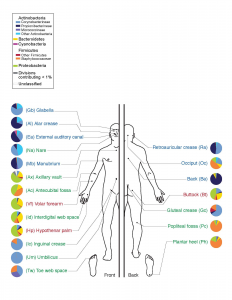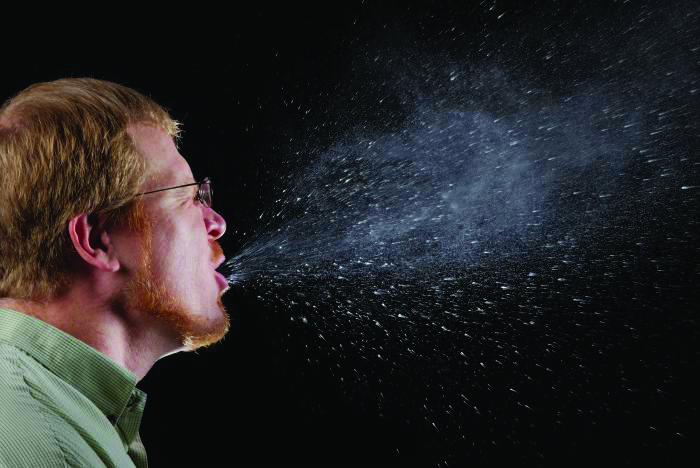When a forensic analyst steps onto a crime scene, she scans the ground for any biological evidence that can be used to identify the culprit — a strand of hair, a pool of blood, a fingerprint. But if these telling items are nowhere to be found, what is a detective to do? Thanks to a recent study conducted by a University of Oregon team, our forensic analyst might simply sample the air. These researchers found that the human microbiome emits trace biological particles collectively comprising a microbial cloud.
The human microbiome is vast, consisting of microbes in and on the human body. Each hour, it emits upwards of one million biological particles through a variety of mechanisms: direct contact with surfaces, aerosol emissions from the body, and dust shed through skin cells and hair. These mechanisms produce personal clouds of invisible bacteria that hover around individuals. Although scientists have been studying human interaction with airborne microbes for more than a century, most of the research up until now has focused on disease causing microbes. Scientists have only recently realized that interaction with other sorts of airborne microbes is integral to our health. This discovery prompted further research, which will have applications in solving crimes through forensics and better understanding human health through medical research.
The University of Oregon team set out to study microbial clouds and the information they reveal. First, the researchers placed volunteers in sterile climate chambers and sampled the air inside, comparing the microbial makeup of an occupied chamber to a sterile one. Then, they performed a second experiment to explore differences among the compositions of individual microbial clouds. Using a set-up similar to that of their first experiment, the scientists sequenced and compared microbial emissions from eight volunteers. Analyzing the two experiments in conjunction, the group determined that individuals shed detectable microbial clouds that differ from person to person.
Microbial clouds offer a variety of possibilities for forensic and medical research. Like fingerprints or leftover biological materials, these clouds can be used to link people to geographic locations. Since each individual sheds a distinct combination of microbes, each microbial cloud is unique, with the potential to reveal a person’s gender, age, and much more. A microbial cloud is also much harder to hide than leftover biological materials — blood can be cleaned up, fingerprints can be swiped. Understandably, microbial clouds are incredibly exciting for forensic analysts.

The clouds could also prove useful to researchers studying disease transmission through airborne pathogens, since they offer clues as to how people emit bacteria into the air. Whether a microbe is emitted via aerosols from the mouth or from the skin can influence how epidemiologists attempt to manage the spread of disease. Some outbreaks can be controlled by ensuring that the infected wear surgical masks, while others require quarantine.
While the research done by the scientists at the University of Oregon is promising, it is also preliminary. The composition of an individual’s microbial cloud is variable — her emitted bacteria may differ based on the time of day or changes in her eating habits. Further research is necessary to unveil the intricate correlations between the compositions of microbial clouds and the characteristics they indicate, such as age and gender. We know the microbial cloud can betray certain secrets, but our scientific understanding of this link is still shaky, and definitely incomplete.
Testing up until this point has been conducted in sterile chambers, but normal air contains numerous microbes. Scientists will thus have to learn to distinguish natural air microbes from microbes emitted by humans. Finally, these clouds require a lot of time, money, and effort to analyze. For microbial cloud testing to be a feasible method in forensics and medical research, the DNA sequencing machinery used to determine cloud compositions will need to be made cheaper and more efficient.
Recent studies have shown that microbial clouds have a lot of potential, but also that research has a long way to go. Perhaps, sometime in the future, forensic analysts will be able to bring decisive evidence to criminal court cases by taking quick and easy samples of the air. In the meantime, scientists are left to ponder the mysterious clues housed within our microbial clouds.

